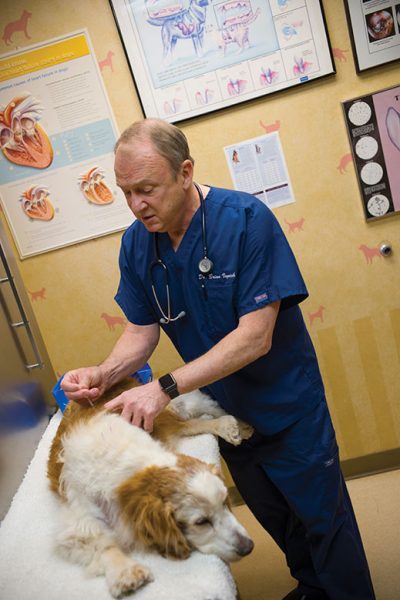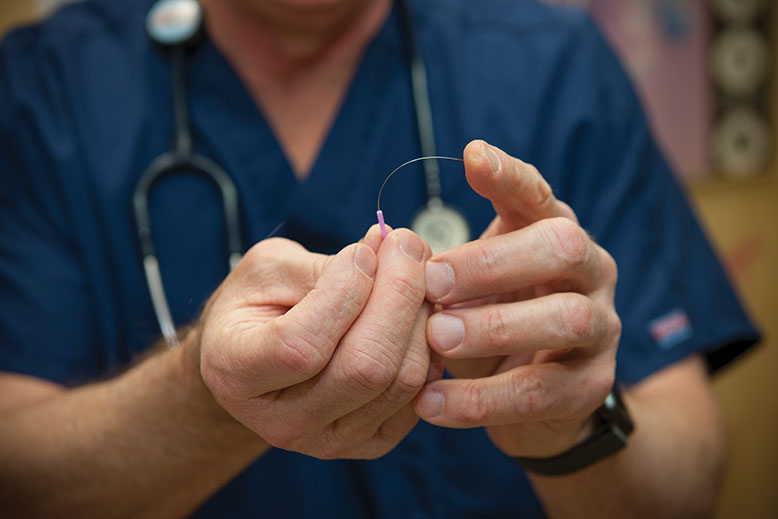
Dr. Brian Voynick, a veterinarian, remembers treating a dog named Milkshake, who suffered from numbness and full paralysis in his hind limbs. For months, the 4-year-old bichon frise had been unable to walk, leaving him to drag himself around with his front legs. He couldn’t empty his bladder without assistance, either. Discussions regarding what to do about Milkshake were grim; euthanasia was a distinct possibility.
Milkshake had been treated with a high-dose steroid regimen, but had not improved. In fact, he was experiencing adverse side effects from the medication. It was too late for surgery, but Voynick offered the dog’s owner an alternative. He suggested acupuncture.
“She looked at me like I had two heads,” says Voynick. He couldn’t make any guarantees, but had had good results using acupuncture to treat certain dogs in similar situations before. Voynick encouraged Milkshake’s owner to try it for two weeks. If the treatments didn’t improve Milkshake’s quality of life, Voynick acknowledged, it would be necessary to euthanize the dog. The owner dried her tears and agreed it was worth a try.
Four treatments later, Milkshake had regained partial mobility in his hind legs. Within a month, the dog was able to walk and run again. “You couldn’t discriminate that dog from my dog or any other dog,” says Voynick.
Stories like Milkshake’s are not uncommon. Veterinarians say a growing number of pet owners are turning to alternative treatments such as acupuncture, Chinese herbal medicine, chiropractic and hydrotherapy for their companions, echoing a trend in human medical care. Of course, it’s important for a veterinarian to examine and diagnose a pet before any alternative treatment is initiated. “Our philosophy is, first do no harm,” says Voynick.
Acupuncture in particular has been embraced at a growing rate, says Voynick. The treatment is utilized in cases of arthritis, musculoskeletal or neurological problems, cancer, chronic pain, gastrointestinal issues, athletic injuries and surgical recovery. It can help stimulate nerves, increase blood circulation, relieve muscle spasms and trigger the release of hormones such as endorphins and cortisol. In animals, as in humans, fine needles are inserted into specific acupuncture points on the body to stimulate a healing response. The insertion of acupuncture needles is virtually painless; some animals become relaxed and even sleepy during a treatment.
“When I got certified in acupuncture in 1996, hardly any veterinarians were certified in the state of New Jersey,” says Voynick. Now there are at least 54 certified by the International Veterinary Acupuncture Society, with 33 who have been certified since 2000. “It was really a springboard to holistic medicine in general,” Voynick adds.
For many animals, alternative treatments are being used in conjunction with traditional medicine. At the American Animal Hospital in Randolph, Voynick takes an integrative approach to veterinary medicine, using tools and treatments such as X-rays, ultrasound, laser surgery, stem-cell therapy and endoscopy, as well as acupuncture and herbal medicine. “You’ve got to have the best of the new and the best of the old,” he says.
Many pets have benefited from such an approach, including Grover, a 13-year-old Welsh springer spaniel with a myriad of symptoms. When he was younger, Grover ran marathons with his owner, Katy Roberts, who lives in Mountain Lakes. Now he suffers from chronic lung disease, arthritic pain and compressed discs along his spine. Some veterinarians might put Grover on anti-inflammatory drugs or steroids, but those drugs can cause ulcers and other side effects. Roberts prefers to minimize the use of conventional pharmaceuticals whenever possible. Instead, Voynick has treated Grover with acupuncture and stem-cell therapy to help regenerate lung cells. He also gives him herbal medicines, such as turkey tail, a mushroom extract that helps reduce swelling and pain.
Grover now comes in once a month for acupuncture treatments, which cost anywhere from $75 to $110 and are typically only covered by the highest tier of pet insurance. “You can tell the difference acupuncture makes,” says Roberts. “There’s no placebo effect with dogs.”
Canines aren’t the only animals that benefit from acupuncture; it can be used on many species of animals, including cats, horses, monkeys, rabbits, and even elephants. “I have cat owners tell me all the time that their cats have gone back to jumping up like they’re kittens again,” Voynick says.
*
Chiropractic treatment of animals dates back to the early 1900s, but it didn’t emerge as an alternative treatment in veterinary medicine until the late 1980s, when Dr. Sharon L. Willoughby, a veterinarian and chiropractor from Illinois, developed the first animal chiropractic training program, Options for Animals. In 1989, she founded the American Veterinary Chiropractic Association (AVCA). Today, there are 574 AVCA-certified doctors in the United States; 11 are located in New Jersey.
Also known as spinal manipulation therapy, veterinary chiropractic can serve as a nonsurgical, drug-free option for correcting joint, disc and soft-tissue disorders. Just like chiropractic care for humans, animal chiropractic is centered around the nervous system. It seeks to correct vertebral subluxations, or misalignments of the vertebrae, with low-force manual manipulation of the spinal column to ensure proper alignment.
“The spine is made up of a bunch of joints, and sometimes the joints can be a little bit frozen,” says Dr. Kenny Fischer, a veterinarian at Hillsdale Animal Hospital in Hillsdale, with certification from the AVCA. “By doing chiropractic, you may be able to help introduce some motion that hasn’t been there for awhile and make [animals] feel better by loosening them up a bit.”
Like acupuncture, chiropractic can be used to treat a wide range of animals and ailments. “It can help with anything, really,” says Fischer. He treats mostly cats and dogs, but horses and birds can also benefit from chiropractic care. Once the pet’s case history has been established, Fischer will observe the animal’s gait and posture, both at rest and in motion, as well as palpate the spine and other areas to determine what adjustments are necessary; animals do not need to be sedated. The length of treatment depends on the pet. An older pet with more chronic problems, such as pain caused by arthritis, may need to be seen every week or two for several treatments, which can cost anywhere between $50-$100 per session—again, typically not covered by insurance. Fischer has also used chiropractic care to treat younger animals with minor physical injuries, such as misalignment caused when a dog collided with a tree while playing outside.

A single-use acupuncture needle, which is 2-inches long, thin and flexible. Photo by John Emerson
“It’s something people should understand the benefits of,” says Fischer, “either as a main treatment or in addition to another.”
*
Three years ago, Casey, a black Labrador retriever, tore the cranial cruciate ligament in his rear left knee, leaving him with a limited ability to stretch and extend his leg. To help get him back to his active self, Casey undergoes hydrotherapy treatments on an underwater treadmill at Valley Animal Hospital in Clifton.
To start, Casey steps into the hydro-treadmill, an open tank with a door that is closed and sealed behind the patient. Warm water slowly rises from the bottom until it reaches a desirable level. That’s when Regan Romanoski, a physical therapist who treats both humans and animals, turns on the treadmill, encouraging Casey to walk using treats as an incentive.
Hydrotherapy is part of canine rehabilitation, which resembles physical therapy for humans. It embraces the use of water as a therapeutic tool and, because of that, is mostly used for dogs. “We can do rehabilitation on cats. Hydrotherapy—not so much,” says Dr. Bruce Henderson, a veterinarian at Valley Animal Hospital, offering canine rehabilitation since 2000.
According to Henderson, hydrotherapy has been commonly used in small-animal rehabilitation since 1990. Before that, it had mostly been used on horses, especially for racehorses that needed to recover from injuries more quickly and stay fit for racing.
“Most of our clients just want their animal to walk and be free of pain,” says Henderson. “One of the goals of what we’re doing is to try to cut down on the amount of medication an animal needs. But we use every tool in our toolbox to get these dogs up and walking again.”
Hydrotherapy can benefit animals struggling with pain, endurance, strength, flexibility or balance issues. “We’ll use it any time we want to help a pet build up muscle tissue without putting a lot of stress on a joint,” says Henderson. It can be used to help treat dogs that are arthritic or dogs that are recovering from some type of orthopedic injury, such as a broken leg or, like Casey, a torn ligament. It can also help get dogs that have had spinal-cord injuries—such as a certain kind of stroke, disc surgery, or a tumor removed from the spinal cord—back on their feet.
The water provides buoyancy so that an animal does not have to support all of its body weight. The water’s hydrostatic pressure can help reduce swelling and decrease pain. The viscosity of water also provides resistance to movement that can help strengthen muscles.
“Think about when you’re in a swimming pool,” says Henderson. “It’s much harder to walk than it is when you’re on dry land, so that works the muscles a lot harder.”
Depending on the plans, most pet insurance companies cover treatments such as hydrotherapy, which can be more cost-effective than surgery, says Henderson. Hydrotherapy typically costs around $100 for a 30-minute session and up to $150 for one hour, including underwater treadmill and other rehabilitation services.
For Henderson and Romanoski, the best reward is seeing canines thrive after hydrotherapy. They both remember one dog who had suffered a stroke and was paralyzed in all four legs when she arrived at Valley Animal Hospital. “She could not get up, could not walk at all,” recalls Henderson. “And she walked out of here about two months afterwards.”
“When the dogs get better,” says Romanoski, “the families get better, too.”



